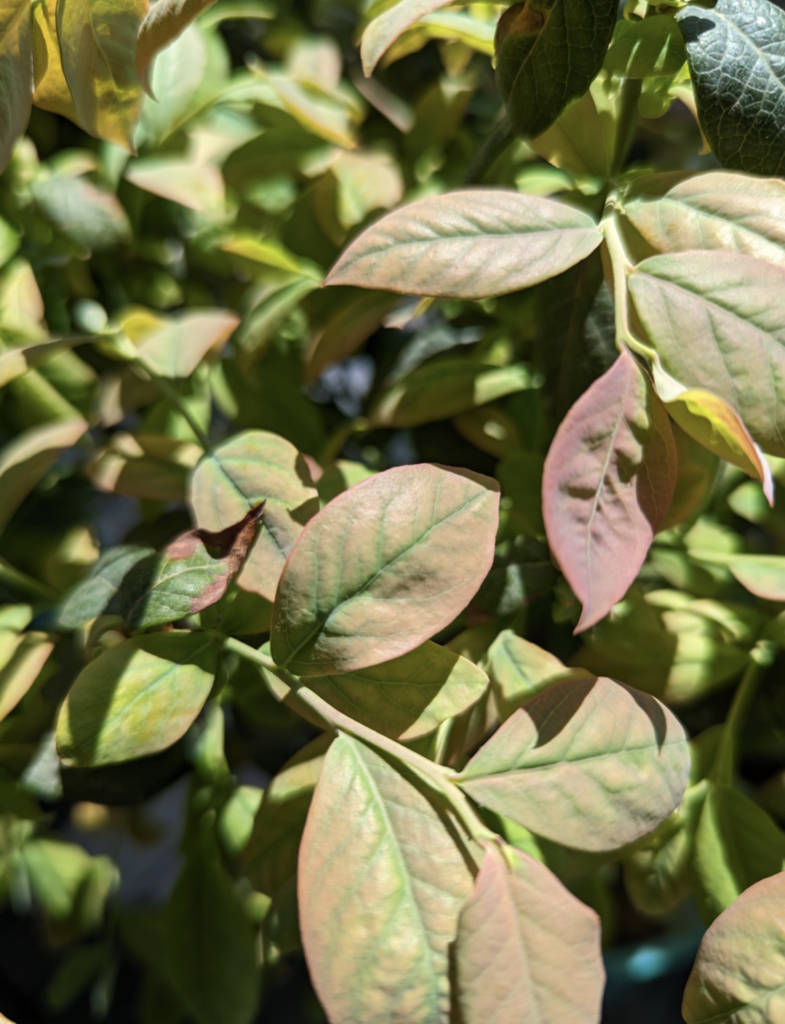
Hello!
I recently got 2 Blueberry plants, one Pink Icing (ZF06-079) and one Peach Sorbet (ZF06-043), and I noticed that the leaves are not as healthy as I’d expect for this time. I’m concerned they are suffering from some level of chlorosis (I attached the pictures bellow). They are in 2gallon containers and they have a little more than one year by now. I’m located in the GTA (zone 6), facing southeast, which gives the blueberries at least 6 hours of sun exposure, their containers have a layer of pine bark nuggets and I keep an eye on the moisture levels of the soil daily (not letting it dry completely).
I haven’t measure the pH of the soil yet, but in the case they are suffering from chlorosis, what would be the best approach for this time of the year? (They are sprouting new leaves and flower buds)
A) applying soil acidifier;
B) transplanting them for another container with some acid potting soil;
C) adding some fertilizer for acid loving plants;
I’m aware that there’s not a perfect solution: some approaches could cause distress to the plant, others would take time. I just would like some help to understand what would be more beneficial to the plants.
Hello – You’ve chosen two beautiful varieties of blueberry. Pink Icing displays some pink in it’s foliage while Peach Sorbet has pink, peach, orange and emerald green leaves. They should make attractive container plants as well as providing abundant berries. I’m not sure why you think your plants may be suffering from chlorosis, indicating an iron deficiency. When deficient in iron, young leaves become pale yellow and stunted and plant growth is poor. It’s always hard to tell in a photo but I’m not seeing any of the characteristic yellow in the leaves in your photo and you’ve noted that there are new leaves and flower buds.
You are right to be concerned about iron deficiency. Iron deficiency is common when the pH of the soil is too high. Blueberries do best with a pH of 4.5-5.0 and will tolerate up to 5.5. Rather than treat a deficiency, I suggest you establish a maintenance program that will maintain the required pH and continue to provide the other nutrients your plant requires. As with any container grown plant, nutrients are being continually washed away with every watering. An article from the University of Wisconsin at the link below describes a good program of fertilization with a caution to avoid overfertilization. Note that the product they specifically mention (Miracid) is no longer available. Look for products that are recommended for acid-loving plants such as azaleas and rhododendrons.
Growing Blueberries in Containers
The other consideration is watering. As noted in the Wisconsin article, blueberries do not like to have ‘wet feet’. The article recommends frequent, light watering with the occasional drench to wash away fertilizer salts. Top up the layer of pine bark nuggets occasionally to keep the container from drying out too quickly.
To read more about growing blueberries, I’m including a link below to an article from OMAFRA (Ontario Ministry of Agriculture, Food and Rural Affairs) on growing blueberries in home gardens and small scale production. It doesn’t specifically address growing blueberries in containers but has good information on their growth requirements and some of the pests and diseases that can affect blueberries.
Growing Blueberries for Home Gardens and Small Scale Production
Hope this helps.

